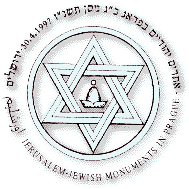Prague
The Altneuschul Synagogue, The Tombstone of Rabbi Judah Loew (MaHaRal of Prague)

 |
Issue: April 1997 Designer: James Janicek Size: 40 mm x 25.7 mm Plate Number: 309 Printers: Government Printers Printing Method: offset |
The Jews in Bohemia and Moravia led a western-European lifestyle, tending by and large to assimilate. In contrast, the Jews of Slovakia and Sub-Carpathian Ruthenia, which for over a thousand years belonged to the Hungarian kingdom, lived a more eastern-European style and were comprised of Orthodox, Neologs (conservatives), and Hassidim.
Although the Jews of Bohemai and Moravia were said to have settled during the Roman period, documentary evidence points only to the existence of a Jewish community in Prague from the end of the 10th century. By the 13th century, however, the works of Jewish scholars attest to a vibrant Jewish culture with a deep affinity for the nation in which they lived.
Jewish communities in the Middle Ages conducted independent lives. They provided for the education and welfare of the community members; collected taxes; settled disputes according to Jewish law; took care of the sick; buried the dead; and built synagogues.
The Altneuschul is the oldest existing synagogue in Europe today. It was completed in 1270 and named the "New" or "Great" synagogue. In the 16th century, with the erection of other synagogues in the ghetto, the Gothic edifice was renamed "The Old-New Synagogue." Its two central pillars divide its hall into two wings, with the pulpit located between them. On the upper part of the wall above the Holy Ark runs the Hebrew acronym of the verse: "Know before whom you are standing." These are the letters that appear on the stamp.
For hundreds of years, the Altneuschul was the center of the Jewish town, with the concourse before it serving as the venue for the Jewish market. Compared to other synagogues of the period, its elegant and imposing appearance was singular -- perhaps because the edifice was erected in the heart of the Jewish quarter without fear of offending the Christian environment's sensibilities.
Numerous legends have been linked to the Altneuschul, also called the "Al Tnai" ("On Condition"). When the Second Temple was destroyed, angels removed stones from the fresh ruins and carried them to the future site of the synagogue in Prague, crying out: "Almighty God, we will return the stones on the condition that the Temple be rebuilt speedily in our time."
During the Renaissance period, Prague's Jewish community gained pre-eminent standing in the Jewish world. The community's intellectual elite, while preserving and observing tradition on the one hand, maintained close ties with non-Jewish scholars and scientists on the other.
Prague's Jewish Emblem
The first day cover shows the official emblem of the Jewish community of Prague -- a Star of David containing a Jewish hat. This emblem, known from the end of the 16th century and displayed on the Jewish quarter's town hall and other public buildings, became a symbol of the Jewish community's autonomy.
On the town hall and the first day cover, the emblem is surrounded by Hebrew letters indicating the date of the building's reconstruction following the community's great fire in 1754.
Some believe that the emblem was conferred on the Jews of Prague by King Ferdinand III in recognition of the Jews' contribution to the war effort in the defence of Prague: the city was invaded by the Swedish in 1648.
The 20th Century
Although Czechoslovakia's Jewish population between the two world wars was only around 350,000 -- less than 2.5% of the population -- its Jews played an important role in commerce, industry and culture. Among them were Sigmund Freud, Gustav Mahler, Franz Kafka and Franz Werfel.
 |
Issue: April 1997 Designer: James Janicek Size: 40 mm x 25.7 mm Plate Number: 310 Printers: Government Printers Printing Method: offset |
During the second half of the 18th century he became the hero of several legends portraying him as a miracle worker and as the creator of the famous Golem (automaton). These legends made him famous, but they also overshadowed his image as a philosopher and expositor. Rabbi Loew wrote copiously in the fields of education and organization. His books, Tifferet Yisrael, Be'er ha-Gola and Nezah Yisrael contain extraordinary philosophical thoughts on nationalism; the People of Israel; the problem of the Exile; and the promise of redemption.
His book Netivot Shalom is not only a thesis on Hassidism, but an entire pedagogic doctrine. Opposed to the method of pilpul (dialectics), the Maharal favored the simple interpretation of the Talmud as a Mishna commentator. He encouraged scientific research so long as it did not conflict with the tenets of Judaism.

